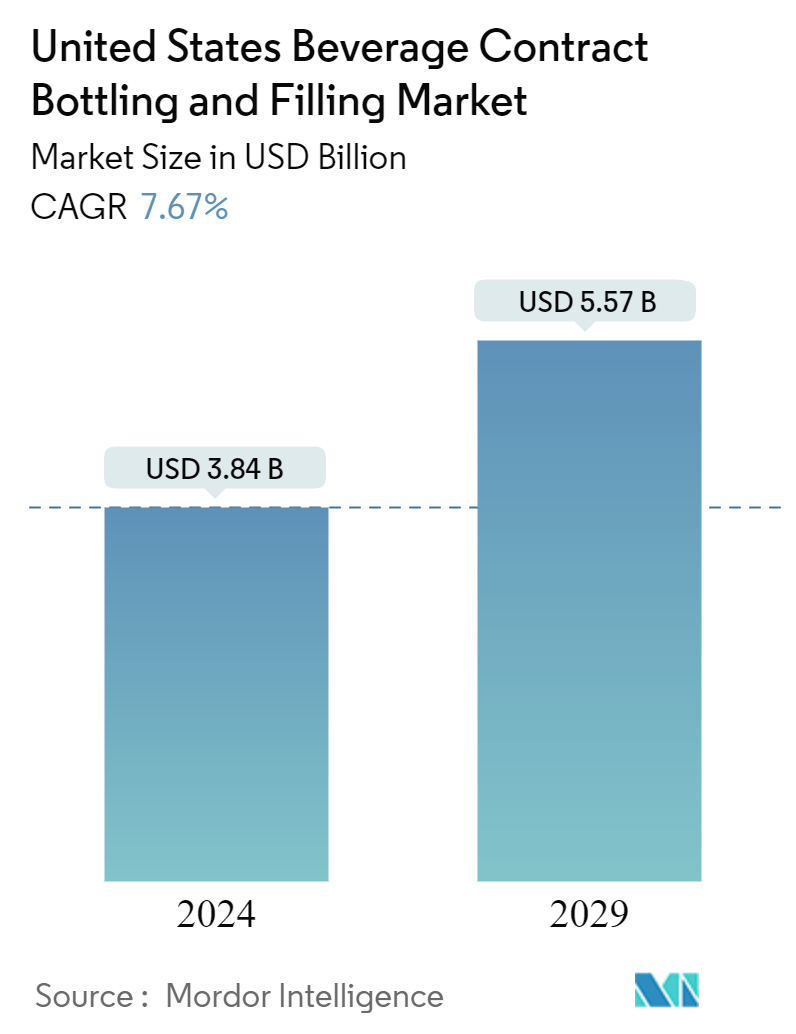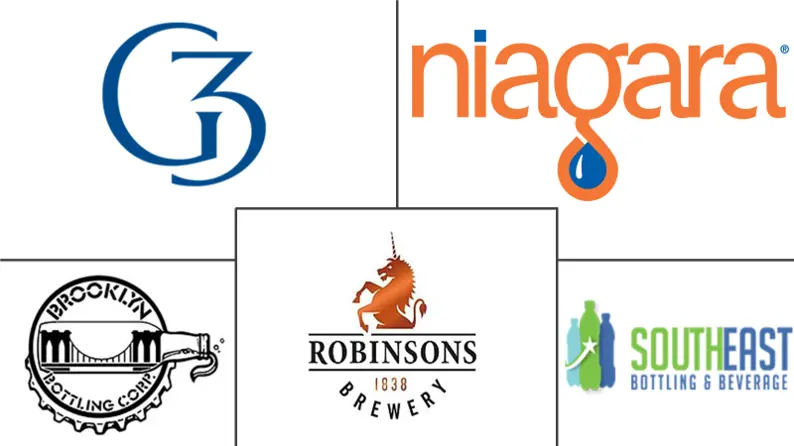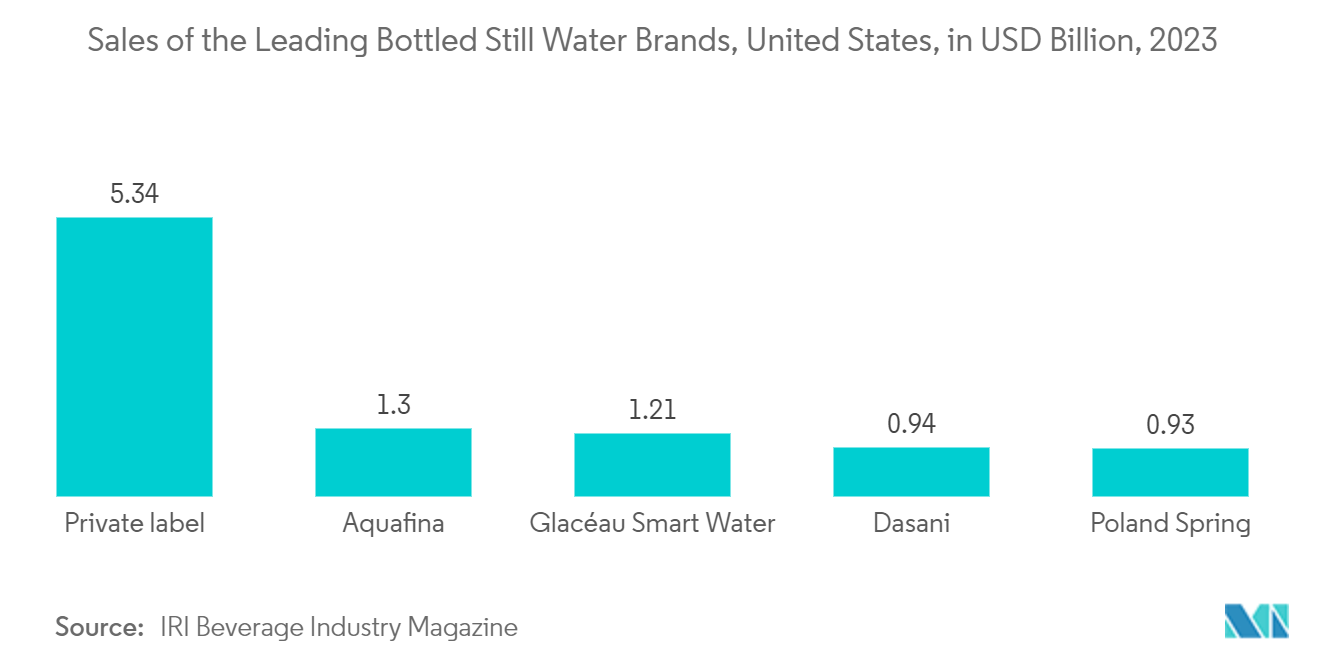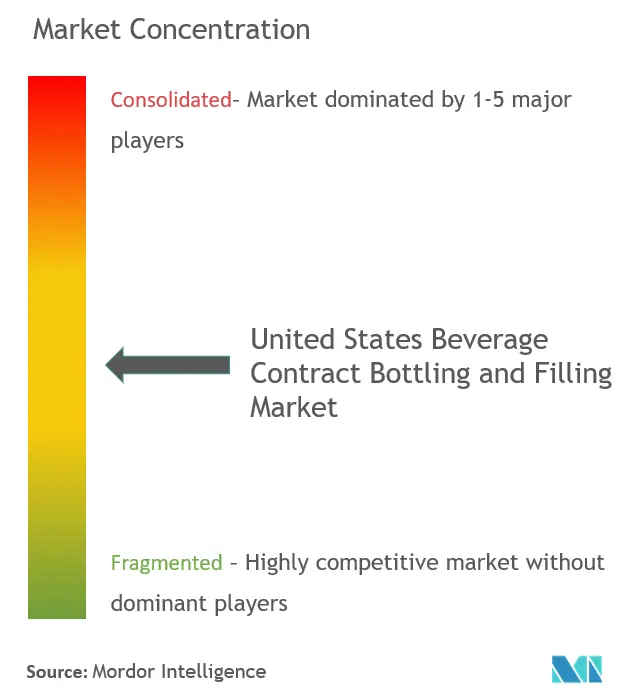United States Beverage Contract Bottling And Filling Market Size

| Study Period | 2019 - 2029 |
| Base Year For Estimation | 2023 |
| Market Size (2024) | USD 3.84 Billion |
| Market Size (2029) | USD 5.57 Billion |
| CAGR (2024 - 2029) | 7.67 % |
| Market Concentration | Medium |
Major Players
*Disclaimer: Major Players sorted in no particular order |
United States Beverage Contract Bottling And Filling Market Analysis
The United States Beverage Contract Bottling And Filling Market size is estimated at USD 3.84 billion in 2024, and is expected to reach USD 5.57 billion by 2029, growing at a CAGR of 7.67% during the forecast period (2024-2029).
Growth in the US beverage contract bottling and filling market is mainly influenced by the changing preferences of manufacturing firms, which usually outsource these specific activities to third-party players. This is because manufacturers focus on cost optimization and their core business. Contract bottling and filling provide several advantages. Firstly, it reduces the operational costs of the manufacturers. In many cases, it is estimated that operational costs can be reduced significantly through outsourcing bottling and filling activities to contract companies and decreasing the costs of machines and labor.
- The manufacturing regulations, especially for beverage products in the United States, are evolving rapidly. Meeting such stringent rules and norms requires several inspection and quality check operations. By outsourcing bottling and filling activities, the hectic task of meeting such regulations is passed on to the contracting agency, motivating more manufacturers to prefer contracting over in-house manufacturing activities. Moreover, the industry is rapidly growing, introducing many new products and technologies. Therefore, companies need to stay updated to meet customers' changing needs.
- Admiral Beverage Corp. is among the largest suppliers of carbonated soft drinks (CSD) in the western United States. It has grown to three extensive facilities supplying carbonated and still beverages, bottled water, and fountain mixes to multiple distributors throughout the mountain, western states, and Alaska. Adopting Bevcorp's MicrO2 system, Admiral Beverage simplified deaeration, optimized blending, and sped up filling and changeovers. The system limits dissolved Oxygen (DO) to reduce foaming, which allows the line to run faster. Faster speeds result in more throughput, decreasing costs per unit, and the correlating reduction in energy costs by not having to refrigerate ingredients.
- With over 3,000 new beverage products being created each year in the United States, beverage contract bottling and filling facilities are in high demand. In February 2020, Big Beverages Contract Manufacturing (BBCM) announced its new beverage co-packing facility in North Carolina. In its new facility, BBCM will begin with one highspeed can line capable of producing 1,200 cans per minute, with plans to add lines two and three over the next 18 months. BBCM plans to provide various canned beverage products for large national and regional customers.
- MSI Express, backed by HCI Equity Partners, headquartered in the United States, acquired Power Packaging. MSI Express provides contract packaging and contract manufacturing services for well-known brands in the shelf-stable human and pet food space. Power also brings MSI Express into categories such as powdered beverages, soups, bases, beverage mixes, food service beverages, coffees, and teas. Power Packaging has four locations: two outside Chicago, one in Wisconsin, and one in Texas. It serves various companies by adding capabilities such as aseptic beverage filling, stick packaging, and filling of jars and cans.
- The COVID-19 pandemic delivered a significant blow to the nation's beverage distribution system. During the pandemic, many US beverage makers, like Coca-Cola, temporarily suspended production across the country's manufacturing facilities. PesiCo's bottling partners in the United States also arrested a significant portion of the output at its manufacturing facilities due to the lockdown.
United States Beverage Contract Bottling And Filling Market Trends
Beer is Expected to Hold Significant Share
- Beer is the most favored alcoholic beverage in the United States. The majority of U.S. consumers showed a preference for a light beer. In contrast to regular beer, this variety has reduced alcohol content and calories. Small and independent breweries continue to be critical contributors to significant communities across the country, finding new ways to innovate and thrive amid evolving consumer preferences and a competitive and maturing beverage market.
- As brewers first launch their operations or begin to grow larger, they can either buy their filling machines or opt for rented filling lines or contract filling solutions. Finding the right filling machinery was complex and could cause significant trouble for beer companies.
- Different filling machines could handle different liquid viscosities, whereas beer has varying filling requirements depending on viscosity and packaging. For these reasons, many companies in the United States are opting for contract bottling and filling, which significantly helps the companies to provide maximum efficiency in bottling and packing.
- In 2023, U.S. beer production and imports collectively dipped by 5%. Concurrently, craft brewer volume sales saw a 1% decline, propelling the market share of small and independent brewers to 13.3%, according to the Brewers Association. The return of beer volume from packaged sales to bars and restaurants was the main factor in the larger dollar sales increase.

Bottled Water is Expected to Witness Significant Growth
- Bottled water is the fastest-growing drink choice in the United States, and Americans spend billions of dollars each year to buy it (Beverage Marketing Corporation). IBWA claimed that bottled water is the healthiest packaged beverage and is particularly crucial as the United States is faced with increased rates of obesity and diabetes. Despite continued growth and increased consumption, bottled water uses the least amount of water and energy of any packaged beverage. One liter of finished product requires only 1.39 liters of water and 0.21 megajoules of energy on average. It is critical in disaster relief. Furthermore, it can only be available in times of emergency if the industry is strong and viable all year.
- As most people were concerned about the impact of the COVID-19 outbreak and were preparing themselves, the demand for bottled water increased significantly. To meet this increase in demand, bottled water companies in the country increased their capacity to provide customers with the water they need. The Federal Emergency Management Agency (FEMA) recommends that one should have a minimum of 1 gallon of water per person within a day available for emergencies. Buying and storing bottled water is a safe and convenient way to ensure an adequate supply is available when needed, and this is expected to boost the demand for bottled water, which, in turn, is expected to positively impact the contract bottling and filling market in the United States.
- According to data published in May 2024 by the International Bottled Water Association, 15.94 billion gallons of bottled water were sold in the United States in 2023. Over the last few years, the country's bottled water sales volume has increased each year significantly.
- Furthermore, the US Food and Drug Administration regulates bottled water as a food product. The FDA does not require bottled water companies to use or report water quality testing results from certified laboratories. The FDA does require ingredient and nutritional information on bottled water labels.
- Recently, Nestlé considered selling most of its bottled water operations in the United States. That business accounts for a significant share of the Swiss food giant's sales and has drawn criticism from environmental groups. Environmental activists regard bottled water as inherently wasteful, at least in countries with drinkable tap water, because of the energy required to transport it to the store. Instances such as this may negatively affect the bottled water contract bottling and filling market in the country.

United States Beverage Contract Bottling And Filling Industry Overview
The US beverage contract bottling and filling market is semiconsolidated, with significant players such as Brooklyn Bottling Group, G3 Enterprises Inc., Southeast Bottling & Beverages, and Niagara Bottling LLC occupying the majority of the market’s share. The companies in the country are forming multiple partnerships and mergers to increase their market share.
- January 2024: Novelis Inc., a global leader in flat-rolled aluminum products and the largest aluminum recycler, announced a new contract with Ardagh Metal Packaging USA Corp. The agreement entails Novelis supplying aluminum beverage packaging sheets to Ardagh Metal Packaging USA Corp.
United States Beverage Contract Bottling And Filling Market Leaders
-
Brooklyn Bottling Group
-
G3 Enterprises, Inc.
-
Southeast Bottling & Beverages
-
Niagara Bottling, LLC
-
Robinsons Breweries (Frederic Robinson Limited)
*Disclaimer: Major Players sorted in no particular order

United States Beverage Contract Bottling And Filling Market News
- April 2024: Refresco, a prominent global provider of beverage solutions for major brands and retailers, finalized its acquisition of VBC Bottling Company, a premium beverage contract manufacturer based in the United States.
- January 2024: Novelis inked a fresh deal with Ardagh Metal Packaging USA. The agreement entails Novelis supplying aluminum beverage packaging sheets to Ardagh's North American metal production sites. Notably, this marks Novelis's third significant contract in under seven months, solidifying its presence in North America's beverage packaging sector.
United States Beverage Contract Bottling And Filling Market Report - Table of Contents
1. INTRODUCTION
- 1.1 Study Assumption and Market Definition
- 1.2 Scope of the Study
2. RESEARCH METHODOLOGY
3. EXECUTIVE SUMMARY
4. MARKET DYNAMICS
- 4.1 Market Overview
- 4.2 Impact of COVID-19 on the US Beverage Industry
-
4.3 Market Drivers
- 4.3.1 CapEx Benefits Offered by Contract Bottlers for Small-scale Beverage Manufacturers
- 4.3.2 Rise in Demand From New-age Drinks and Craft Beer Segment
- 4.3.3 Gradual Change in the Business Model of Contact Packagers Toward a Consultative Approach Involving Design and Placement
-
4.4 Market Challenges
- 4.4.1 Lack of Flexibility and Agility in Manufacturing Processes and Dynamic Nature of Regulations
- 4.5 Value Chain Analysis
-
4.6 Porter's Five Forces Analysis
- 4.6.1 Bargaining Power of Suppliers
- 4.6.2 Bargaining Power of Consumers
- 4.6.3 Threat of New Entrants
- 4.6.4 Threat of Substitute Products
- 4.6.5 Intensity of Competitive Rivalry
5. MARKET SEGMENTATION
-
5.1 By Beverage Type
- 5.1.1 Beer
- 5.1.2 Carbonated Drinks and Fruit-based Beverages
- 5.1.3 Bottled Water
- 5.1.4 Other Beverage Types (Sport Drinks)
6. COMPETITIVE LANDSCAPE
-
6.1 Company Profiles
- 6.1.1 Brooklyn Bottling Group
- 6.1.2 CSD Co-Packers Inc.
- 6.1.3 Southeast Bottling & Beverages
- 6.1.4 G3 Enterprises Inc.
- 6.1.5 Robinsons Breweries (Frederic Robinson Limited)
- 6.1.6 Western Innovations Inc.
- 6.1.7 Niagara Bottling LLC
- *List Not Exhaustive
7. FUTURE OUTLOOK OF THE MARKET
** Subject To AvailablityUnited States Beverage Contract Bottling And Filling Industry Segmentation
The study tracks the revenue accrued by the services offered, including bottling and filling, which are outsourced by third-party vendors with substantial expertise in the area. Beverage types such as beer, carbonated drinks and fruit-based beverages, and bottled water are included in the scope. At the same time, the contract bottling and filling market studied is only for the beverage industry. The current trade scenario and the significant investments and acquisitions by players in the United States are also analyzed in the study. The market sizes and forecasts are provided in terms of value (USD) for all the above segments.
| By Beverage Type | Beer |
| Carbonated Drinks and Fruit-based Beverages | |
| Bottled Water | |
| Other Beverage Types (Sport Drinks) |
United States Beverage Contract Bottling And Filling Market Research FAQs
How big is the United States Beverage Contract Bottling And Filling Market?
The United States Beverage Contract Bottling And Filling Market size is expected to reach USD 3.84 billion in 2024 and grow at a CAGR of 7.67% to reach USD 5.57 billion by 2029.
What is the current United States Beverage Contract Bottling And Filling Market size?
In 2024, the United States Beverage Contract Bottling And Filling Market size is expected to reach USD 3.84 billion.
Who are the key players in United States Beverage Contract Bottling And Filling Market?
Brooklyn Bottling Group, G3 Enterprises, Inc., Southeast Bottling & Beverages, Niagara Bottling, LLC and Robinsons Breweries (Frederic Robinson Limited) are the major companies operating in the United States Beverage Contract Bottling And Filling Market.
What years does this United States Beverage Contract Bottling And Filling Market cover, and what was the market size in 2023?
In 2023, the United States Beverage Contract Bottling And Filling Market size was estimated at USD 3.55 billion. The report covers the United States Beverage Contract Bottling And Filling Market historical market size for years: 2019, 2020, 2021, 2022 and 2023. The report also forecasts the United States Beverage Contract Bottling And Filling Market size for years: 2024, 2025, 2026, 2027, 2028 and 2029.
United States Beverage Contract Bottling And Filling Industry Report
The report covers US contract bottling and beverage filling manufacturers, providing an in-depth industry analysis. The market is segmented by beverage type, including beer, carbonated drinks and fruit-based beverages, bottled water, and other beverage types. The market analysis includes market size, market share, market research, and market trends, offering a comprehensive industry overview.
The industry report includes historical data and a market forecast outlook, providing insights into market growth and market value. The market report highlights industry statistics and industry trends, which are crucial for understanding market segmentation and market predictions.
This report example includes detailed industry information and industry research, making it a valuable resource for research companies. The industry sales and industry size are analyzed to provide a clear market overview and market outlook.
Market leaders are identified, giving insights into market data and market review. The report also includes a report PDF download, which is an essential tool for anyone looking to understand the market forecast and market growth rate.
Overall, this industry report is a comprehensive guide for understanding the US contract bottling and beverage filling market, offering valuable insights and detailed analysis for stakeholders and industry players.



